Association between dietary antioxidant indices and hypertension among Chinese adults
IF 4.3
2区 医学
Q1 PERIPHERAL VASCULAR DISEASE
引用次数: 0
Abstract
The effect of dietary antioxidants on blood pressure (BP) regulation and hypertension risk remains largely unknown. This study aimed to comprehensively assess the impacts of dietary antioxidants on systolic BP (SBP), diastolic BP (DBP), mean arterial pressure (MAP), and pulse pressure (PP), and hypertension risk among Chinese adults. The cross-sectional study assessed data from 12,046 Chinese adults, evaluating dietary antioxidant quality scores (DAQS) and total antioxidant capacity (DTAC) via a validated food frequency questionnaire. MAP was derived using the formula DBP + (0.412 ×PP), with PP calculated as SBP - DBP. The relationship between DAQS, DTAC, and hypertension prevalence was analyzed using multivariable logistic regression. Among participants not taking antihypertensive medications, those in the highest groups of DTAC and DAQS had significantly lower SBP, DBP, MAP, and PP compared to those in the lowest groups (all p-trends <0.001). Relative to the lowest quintile (Q1) of DTAC (adjusted odds ratios (OR) for hypertension decreased in Q2 (OR 0.90, 95%CI 0.79–1.03), Q3 (OR 0.65, 95% CI 0.56–0.76), Q4 (OR 0.51, 95% CI 0.43–0.60), and Q5 (OR 0.38, 95% CI 0.31–0.46) (p trend <0.001). For DQAS, hypertension OR of category 5 was 0.38 (95% CI 0.32–0.46) compared to that of category 1. Increased vitamin A, Zinc, and selenium intake correlated with reduced hypertension risk. A significant non-linear DTAC and linear DAQS relationships were observed and hypertension risk. Antioxidant-rich diets markedly lowered SBP, DBP, MAP, PP, and hypertension risk.


中国成年人膳食抗氧化指数与高血压之间的关系
膳食抗氧化剂对血压(BP)调节和高血压风险的影响在很大程度上仍然未知。本研究旨在全面评估膳食抗氧化剂对中国成年人收缩压(SBP)、舒张压(DBP)、平均动脉压(MAP)和脉压(PP)以及高血压风险的影响。这项横断面研究评估了来自 12046 名中国成年人的数据,通过有效的食物频率问卷评估了膳食抗氧化剂质量得分(DAQS)和总抗氧化剂能力(DTAC)。MAP 的计算公式为 DBP + (0.412 ×PP),PP 的计算公式为 SBP - DBP。采用多变量逻辑回归分析了 DAQS、DTAC 和高血压患病率之间的关系。在未服用降压药的参与者中,DTAC和DAQS最高组的参与者的SBP、DBP、MAP和PP均显著低于最低组(所有P趋势均为0.001)。相对于 DTAC 的最低五分位数(Q1),Q2(OR 0.90,95%CI 0.79-1.03)、Q3(OR 0.65,95% CI 0.56-0.76)、Q4(OR 0.51,95% CI 0.43-0.60)和 Q5(OR 0.38,95% CI 0.31-0.46)的调整后高血压几率比(OR)有所下降(p 趋势为 <0.001)。就 DQAS 而言,第 5 类高血压 OR 值为 0.38(95% CI 0.32-0.46),而第 1 类则为 0.38(95% CI 0.32-0.46)。维生素 A、锌和硒摄入量的增加与高血压风险的降低相关。DTAC和DAQS与高血压风险呈明显的非线性关系。富含抗氧化剂的饮食可显著降低 SBP、DBP、MAP、PP 和高血压风险。
本文章由计算机程序翻译,如有差异,请以英文原文为准。
求助全文
约1分钟内获得全文
求助全文
来源期刊

Hypertension Research
医学-外周血管病
CiteScore
7.40
自引率
16.70%
发文量
249
审稿时长
3-8 weeks
期刊介绍:
Hypertension Research is the official publication of the Japanese Society of Hypertension. The journal publishes papers reporting original clinical and experimental research that contribute to the advancement of knowledge in the field of hypertension and related cardiovascular diseases. The journal publishes Review Articles, Articles, Correspondence and Comments.
 求助内容:
求助内容: 应助结果提醒方式:
应助结果提醒方式:


